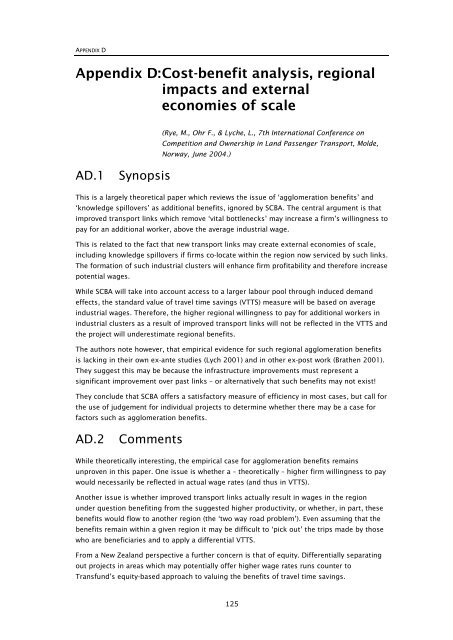Research 350 - NZ Transport Agency
Research 350 - NZ Transport Agency
Research 350 - NZ Transport Agency
Create successful ePaper yourself
Turn your PDF publications into a flip-book with our unique Google optimized e-Paper software.
APPENDIX D<br />
Appendix D: Cost-benefit analysis, regional<br />
impacts and external<br />
economies of scale<br />
(Rye, M., Ohr F., & Lyche, L., 7th International Conference on<br />
Competition and Ownership in Land Passenger <strong>Transport</strong>, Molde,<br />
Norway, June 2004.)<br />
AD.1<br />
Synopsis<br />
This is a largely theoretical paper which reviews the issue of ‘agglomeration benefits’ and<br />
‘knowledge spillovers’ as additional benefits, ignored by SCBA. The central argument is that<br />
improved transport links which remove ‘vital bottlenecks’ may increase a firm’s willingness to<br />
pay for an additional worker, above the average industrial wage.<br />
This is related to the fact that new transport links may create external economies of scale,<br />
including knowledge spillovers if firms co-locate within the region now serviced by such links.<br />
The formation of such industrial clusters will enhance firm profitability and therefore increase<br />
potential wages.<br />
While SCBA will take into account access to a larger labour pool through induced demand<br />
effects, the standard value of travel time savings (VTTS) measure will be based on average<br />
industrial wages. Therefore, the higher regional willingness to pay for additional workers in<br />
industrial clusters as a result of improved transport links will not be reflected in the VTTS and<br />
the project will underestimate regional benefits.<br />
The authors note however, that empirical evidence for such regional agglomeration benefits<br />
is lacking in their own ex-ante studies (Lych 2001) and in other ex-post work (Brathen 2001).<br />
They suggest this may be because the infrastructure improvements must represent a<br />
significant improvement over past links – or alternatively that such benefits may not exist!<br />
They conclude that SCBA offers a satisfactory measure of efficiency in most cases, but call for<br />
the use of judgement for individual projects to determine whether there may be a case for<br />
factors such as agglomeration benefits.<br />
AD.2<br />
Comments<br />
While theoretically interesting, the empirical case for agglomeration benefits remains<br />
unproven in this paper. One issue is whether a – theoretically – higher firm willingness to pay<br />
would necessarily be reflected in actual wage rates (and thus in VTTS).<br />
Another issue is whether improved transport links actually result in wages in the region<br />
under question benefiting from the suggested higher productivity, or whether, in part, these<br />
benefits would flow to another region (the ‘two way road problem’). Even assuming that the<br />
benefits remain within a given region it may be difficult to ‘pick out’ the trips made by those<br />
who are beneficiaries and to apply a differential VTTS.<br />
From a New Zealand perspective a further concern is that of equity. Differentially separating<br />
out projects in areas which may potentially offer higher wage rates runs counter to<br />
Transfund’s equity-based approach to valuing the benefits of travel time savings.<br />
125
















